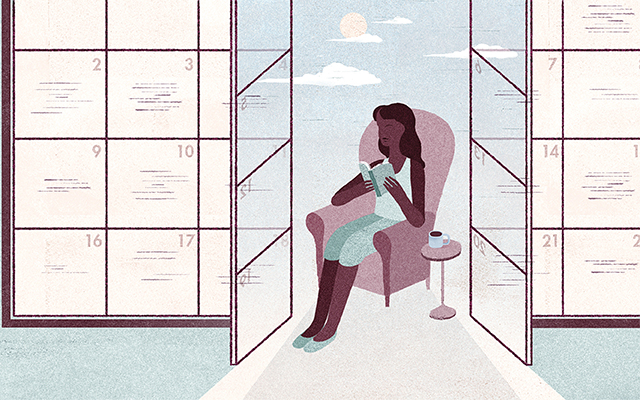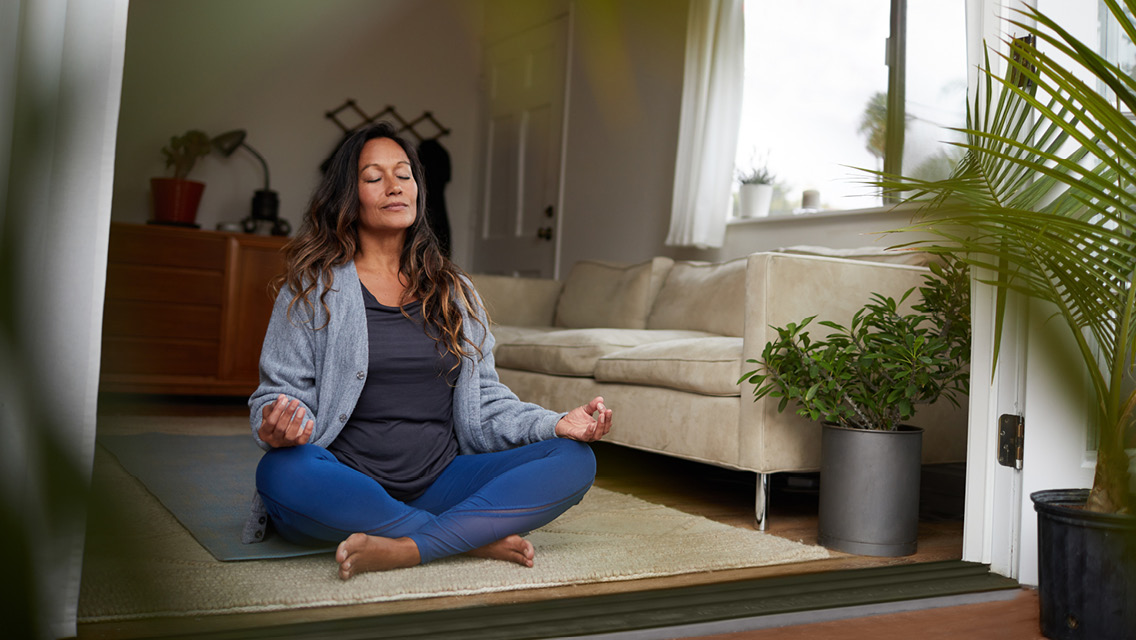ARTICLE SHORTCUTS
Be for Real | Take the Road to Nowhere | Unplug and Recharge | Keep the Sabbath
When I was 29, I had the life I always dreamed of as a boy: a 25th-floor office in Midtown Manhattan, an apartment on Park Avenue and 20th Street, and an endlessly fascinating job. Writing for Time magazine, I covered the fall of apartheid in South Africa, the People Power Revolution of the Philippines, and the turmoil around Indira Gandhi’s assassination. With no dependents or domestic responsibilities, I took long vacations, traveling everywhere from El Salvador to Bali.
In the midst of all the daily excitement and accomplishment, however, was a voice inside telling me that I was racing around too fast to really see or enjoy where I was going — or to check whether I was truly happy.
Indeed, hurrying around in search of contentment seemed a perfect way of guaranteeing I’d never find it. Too often, I reminded myself of someone going on and on about world peace in the most contentious and divisive terms.
So I decided to leave my dream life and spend a year in a small, single room on the backstreets of the ancient Japanese capital of Kyoto. At the time I couldn’t have explained exactly why I was doing this, except that I felt I had enjoyed a wonderful diet of movement and stimulation in New York, and it was time to balance that with something simpler. It was time to learn how to make these joys less external and ephemeral and to learn the art of sitting still.
Going nowhere — as my boyhood hero, singer-songwriter Leonard Cohen, would later tell me — isn’t about turning your back on the world; it’s about stepping away now and then so you can see it more clearly and love it more deeply. These four practices can help you experience more quiet in your daily life, no matter where you are.
Be for Real
One day — 4 in the morning at the end of December, to be exact — Cohen took time out from his meditations to meet me for an interview and talk about what he was doing at the Mt. Baldy Zen Center near Los Angeles.
Sitting still, he said with unexpected passion, was “the real deep entertainment” he had found in his 61 years on the planet. “Real profound and voluptuous and delicious entertainment. The real feast that is available within this activity.”
Was he kidding? Cohen is famous for his mischief and ironies. But as he went on, I realized he wasn’t joking.
“What else would I be doing?” he asked. “Would I be starting a new marriage with a young woman and raising another family? Finding new drugs, buying more expensive wine? I don’t know. This seems to me the most luxurious and sumptuous response to the emptiness of my own existence.”
As I observed the sense of attention, kindness, and even delight that seemed to come out of Cohen’s life of going nowhere, I began to think about how liberating it might be for any of us to practice sitting still — clearing our heads and quieting our emotions.
You could start just by taking a few minutes out of every day to sit quietly and do nothing, letting what moves you rise to the surface. You could enjoy a long walk in the wilderness, or take a few days out of every season to go on retreat, exploring what lies deeper within the moment or yourself.
You could, as Cohen was doing, try to find a life in which stage sets and performances disappear and be reminded, at a level deeper than all words, about how making a living and making a life sometimes point in opposite directions.
Take the Road to Nowhere
The idea of going nowhere is as universal as the law of gravity. “All the unhappiness of men,” the 17th-century French mathematician and philosopher Blaise Pascal famously noted, “arises from one simple fact: that they cannot sit quietly in their chamber.”
After Admiral Richard E. Byrd spent nearly five months alone in a shack in the Antarctic, in temperatures that sank to 70 degrees below zero, he emerged convinced that “half the confusion in the world comes from not knowing how little we need.”
Or, as they sometimes say around Kyoto, “Don’t just do something. Sit there.”
Yet the world in which Pascal and even Admiral Byrd lived seems positively tranquil by today’s standards. The amount of data humanity collects while you’re reading a book is five times greater than the amount that exists in the entire Library of Congress. Anyone reading my full book, The Art of Stillness, will take in as much information today as Shakespeare took in during his lifetime. Researchers in the field of interruption science have found that it takes an average of 25 minutes to recover from a phone call. Yet such interruptions come every 11 minutes, on average — which means we’re never caught up with our lives.
So the more data that comes streaming in on us, the less time we have to process any of it.
The one thing technology doesn’t provide is a sense of how to make the best use of it. The ability to gather information, which used to be so crucial, is far less important now than the ability to sift through it.
It’s easy to feel as if you’re standing 2 inches away from a huge canvas that’s crowded and changing every microsecond. It’s only by stepping back and standing still that you can begin to take in the larger picture and see what that canvas — which is your life — really means.
Unplug and Recharge
I’ve always been surprised to find that the people who have worked to speed up the world are often the same ones most sensitive to the virtue of slowing down.
One day I visited the Google headquarters to give a talk on the Dalai Lama book I’d written and, like most visitors, I was impressed by the trampolines, the indoor tree houses, and the freedom that workers had to let their minds wander off leash to wherever inspiration might be hiding.
Many Silicon Valley employees observe an Internet Sabbath every week, turning off most of their devices from Friday night to Monday morning, if only to regain the sense of proportion and direction they’ll need when they go back online.
There is now a meditation room in every building on the General Mills campus in Minneapolis. Congressman Tim Ryan leads his colleagues in sessions of sitting still, reminding them that, if nothing else, scientists have found that meditation can lower blood pressure, help boost our immune systems, and even change the architecture of our brains.
A growing percentage of American companies now have stress-reduction programs, and the number is increasing by the day. More than 30 percent of those enrolled in such a program at Aetna, the giant healthcare company, saw their stress levels drop by a third after only an hour of yoga each week.
The computer-chip maker Intel experimented with a quiet period of four hours every Tuesday, during which 300 engineers and managers were asked to turn off their email and phones and put up Do Not Disturb signs on their office doors to make space for “thinking time.” The response proved so enthusiastic that the company inaugurated an eight-week program to encourage clearer thinking.
After a similar seven-week program at General Mills, 80 percent of senior executives reported an improvement in their ability to make decisions, and 89 percent said they had become better listeners. Such developments are saving American corporations $300 billion a year; more important, they’re a form of preemptive medicine at a time when the World Health Organization has projected that “stress will be the health epidemic of the 21st century.”
It may be strange to see mind training — going nowhere, in effect — being embraced by forward-pushing organizations. And it’s true, the businesses that view mindfulness practices as opportunities for advancing their goals may simply be deploying new and imaginative means to the same un-elevated ends: searching for ways to squeeze ever more productivity from their employees.
To me, the point of sitting still is to help you see through the very idea of pushing forward; it leads you to a place where you’re defined by something larger. Its benefits lie within some psychological account with a high interest rate but long-term yields, to be drawn upon at the moment when a doctor walks into the room shaking his head, or another car veers in front of yours, and all you have to draw upon is the clarity and focus you’ve collected in your deeper moments.
Keep the Sabbath
The one word for which the adjective “holy” is used in the Ten Commandments is “Sabbath.” But keeping the Sabbath — doing nothing for a while — is one of the hardest things in life for me. I’d much rather give up meat or wine or sex than the option of checking my emails or getting on with my work when I want to. If I don’t answer my messages today, I tell myself, there will only be more to answer tomorrow (though, in truth, refraining from sending messages will likely diminish the number I receive). If I take time off, I somehow believe, I’ll be that much more hurried when I return to work.
Whenever I finally force myself away from my desk for a day, of course, I find the opposite: The more time I spend away from my work, the better the work will be.
One day, Mahatma Gandhi was said to have woken up and told those around him, “This is going to be a very busy day. I won’t be able to meditate for an hour.” His friends were taken aback at this rare break from his discipline. “I’ll have to meditate for two,” he explained.
I mentioned this once on a radio program and a woman called in, understandably impatient. “It’s all very well for a male travel writer in Santa Barbara to talk about taking time off,” she said. “But what about me? I’m a mother trying to start a small business, and I don’t have the luxury of meditating for two hours a day.”
Yet it’s precisely those who are busiest, I wanted to tell her, who most need to give themselves a break. Stress is contagious. If the overburdened mother could ask her spouse — or her mother or a friend — to look after her kids for 30 minutes a day, I’m sure she’d be more relaxed and have more energy and joy to share with her children (and with her business) when she came back.
Space, as Karl Marx explained it in another context, has been annihilated by time. This is especially true today. We feel as though we can connect with anyone, almost anywhere, at any moment. And the more we contact others, the more it seems we lose contact with ourselves.
When I left New York City for the backstreets of Kyoto, I figured I’d be growing poorer in terms of money, amusements, social life, and obvious prospects, but I’d be richer in what I prize most: days and hours.
This is what the principle of the Sabbath enshrines. It is, as the great Jewish theologian Abraham Joshua Heschel put it, “a cathedral in time rather than in space.”
The one day a week we take off becomes a vast empty space through which we can wander, without agenda. It’s like a retreat house that ensures we’ll have something bright and purposeful to carry back into the other six days. The Sabbath reminds us that, in the end, all our journeys have to bring us home.
It takes courage, of course, to step out of the fray, just as it takes courage to do anything that’s necessary, whether it’s turning away from that sugarcoated doughnut or tending to a loved one on her deathbed. And with billions of our global neighbors in crying need, with so much in every life that has to be done, it can sound selfish to take a break or go off to a quiet place. But as soon as you sit still, you find that it actually brings you closer to others, in both understanding and sympathy.
In any case, few of us have the chance to step out of our daily lives often, or for very long. Nowhere can become somewhere we visit in the quiet corners of our lives by just sitting quietly for 30 minutes every morning (a mere 3 percent of our waking hours). The point of gathering stillness is not to enrich the sanctuary or mountaintop but to bring that calm into the motion and commotion of the world.
Because, in an age of speed, nothing can be more invigorating than going slow. In an age of distraction, nothing can feel more luxurious than paying attention. And, in an age of constant movement, nothing is more urgent than sitting still.
Slow It Down
Experience Life readers and team members share where they find their moments of stillness.
- Browsing at the bookstore. — Holly D., Minneapolis
- Enjoying my morning coffee, which can sometimes last a few hours. — Karen N., St. Paul, Minn.
- Early mornings on a sun-drenched couch with a drowsy cat on my lap, watching the sun slant through the dining-room windows, and feeling grateful for the roof over our heads.— Craig C., Experience Life
- Walking, hiking, and biking. — T. C. L., Frisco, Colo.
- Lying in my hammock in the summer. — Laura Y., Minneapolis
- Floating quietly in a sensory deprivation tank.— Jane M., Experience Life
- Sitting in a hay field. — Luisa G., Menomonie, Wis.
- Cradling my sweet dog’s face in my hands and looking into those deep loving eyes. — Betty A., Bozeman, Mont.
- Digging in my garden. — Darby L., Experience Life
- As a flight attendant, my stillness moments are when I just pause for even a moment to reflect on gratitude. Smile at someone. — Mary B. G., St. Augustine Beach, Fla.
- Sitting outside at the barn, gazing at the horses. — Lydia A., Experience Life
- I love taking the time each day to write down what I’m grateful for. This practice has helped me keep my focus on the positive aspects of life! — Holly T., Snoqualmie, Wash.
- Sitting out in my backyard with my dogs cuddled next to me, drinking tea, listening to the birds, feeling the wind, and soaking in the sunshine. — Holly D., Fort Collins, Colo.
- Watching branches on trees or their leaves move in the wind. — Casie L., Experience Life




This Post Has 0 Comments